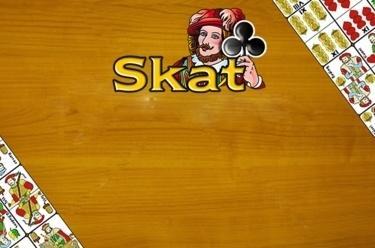
Skat
Game instructions
Getting started
Start a new game or join an open game of a fellow player.
If you start a new game you decide who is allowed to play on the table, how many players the table allows, how high the stakes are per point and your limit.
You can also choose between duel rules and tournament rules. In tournament games, you play against 2 real opponents.
At the edge of the table, you can see whose turn it is, the time remaining to take your turn, the stake and your credit. You can also see the bid value, the declared game and the trump suit in trump games. The game shows, whose turn it is and when it is your turn. The forehand is marked accordingly. You can chat with your fellow players using the chat function.
Gameplay
The Skat deck has 32 cards in 4 suits. The card game is played with three players, which can lead to temporary alliances because one player always plays solo against the other two.
The number of trump cards varies depending on the game variant. Basically jacks and the cards of the suit called can be trumps. There are 3 distinct games with Skat:
Suit games
In Suit games, the jacks along with the suit called are trumps, which means there are 11 trump cards. The sequence of trumps is (descending): Jack of clubs – jack of spades – jack of hearts – jack of diamonds – trump ace – trump 10 – trump king – trump queen – trump 9, 8, 7. With the other suits the sequence is ace – 10 – king – queen – 9 – 8 – 7.
Grand games
In Grand games there are only 4 trumps: the 4 jacks in the order clubs, spades, hearts, diamonds. All suits are of equal value. With the other suits the sequence is ace – 10 – king – queen – 9 – 8 – 7.
Null games
There are no trumps in Null games, the jacks are normal suit cards. The sequence in Null games is always ace – king – queen – jack – 10 – 9 – 8 – 7. In contrast to Suit and Grand games the 10 is not ranked after the ace but after the jack.
With Suit and Grand games the soloist has to reach 61 points with his tricks to win the game; with a Null game the soloist must lose all tricks.
Bidding
Each player is dealt 10 cards. 2 cards are placed face down in the middle of the table, they form the Skat. The players are called clockwise fore hand, middle hand and post hand. The fore hand listens first to the bidding of the middle hand. If one of the two players passes, the post hand bids higher or passes. If none of the 3 players bids, the round is cancelled and the cards will be dealt again.
The minimum bidding value is 18. What happens next depends on the possible game values: 20, 22, 23, 24, 27 etc. The hand determines how high you should bid and the peaks determine how high you can bid.
Peaks
Trumps in consecutive order are called peaks. The number of peaks is relevant to determine the bidding factor and the game value at the end. When calculating the point score the cards in the Skat will also be included to determine the peaks of a soloist player. In accordance with the number of trumps of a game there are 11 peaks in Suit games, 4 peaks in Grand games and no peaks in Null games.
To determine the peaks you count how many consecutive trumps you hold starting with the highest trump, the jack of clubs. A player, who has in his hand for example jack of clubs, jack of spades and jack of diamonds but not jack of hearts can play with 2 peaks. You can play without peaks but these also have to be consecutive from the first trump card. If your first trump card is the king, you can play without 6 peaks (you miss the 4 jacks, the trump ace and the trump 10). But you should also factor your hand into your decision how high you are going to bid because not every game that you can bid according to the peaks is winnable.
To determine the bidding value the peaks will be determined and multiplied by the game value of the suit (clubs: 12, spades: 11, hearts: 10, diamonds: 9) or by 24, the basic value for a Grand. The following formula is applied: Bidding value = (peaks + calls) x game value.
The following bids are possible:
- "Hand" means that you do not use the Skat.
- With “Schneider” the opposing team cannot have more than 30 points in their tricks.
- If you bid "Schwarz" the opposing team must not take any tricks.
- "Open/Ouvert" means that you disclose your cards for your opponents.
Table: Determining the bid value
Overbidding
At the end of the game the actual game score has to reach at least the bidding value. If this isn't the case the soloist has overbid and lost the game. This might also happen when you pick up the Skat and then have another jack in your hand. In this case you should call a higher game.
Game calls
The soloist now picks up the Skat and then lays down 2 cards face-down ("Drücken"). If he/she wants to play a Hand game the Skat remains face-down on the table. The Skat that hasn't been picked up as well as the cards laid down will count along with the tricks for the final score.
Then the soloist will either call a Suit game, Grand game or a Null game. With Ouvert or Ouvert Hand the cards will be disclosed for the other players.
Play
After the game calls the game begins. Irrespective of who is the soloist the first hand plays a random card; the other players lay a card clockwise in the middle. The players have to follow suit but not trump, unless trump has been played: In this case the other players have to play trump if possible. If you don't have the trump or suit played you can play a random card. If you don't play alone it can be useful to "schmieren" a card to your partner, to make sure that the soloist takes as little points as possible in his tricks.
The trick is won by the player who played the highest card of the suit or the highest trump. The player who takes a trick is the next to play.
Give up
The button "Give Up" appears as soon as you can give up a game voluntarily. The soloist can always give up when it's his turn. The other players can only give up when the cards of the declarer have been disclosed.
End of the game
A round is finished when all cards have been played, a player has given up or the soloist has taken a trick in a Null game. The round will then be settled up.
Scoring
The game value of a Skat round will be calculated with the following formula:
Game value = basic score x (peaks + winning level)
The basic scores of the Suit games and the Grand games as well as the fixed game scores of Null games can be taken from the bidding chart.
With Suit and Grand games the soloist has to reach at least 61 points to win the relevant game value. To win with Null games you cannot take any tricks.
The winning level determines how high a game has been won. The winning levels for Skat games are 1 to 3 and in Hand games 2 to 7.
Skat games
- 1 = simple game
- 2 = Schneider (opposing team/soloist reaches only 30 or less points)
- 3 = Schwarz (opposing team/soloist takes no tricks)
Hand games
- 2 = simple game
- 3 = Schneider
- 4 = Schneider called
- 5 = Schwarz
- 6 = Schwarz called
- 7 = open
The following applies for the soloist: If the soloist loses on the winning level called he/she loses at least on the winning level called or the opposing team wins on the winning level called. But if the soloist reaches a higher level with his game, the higher level counts.




